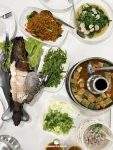สำหรับภาษาไทย กดอ่านได้ที่นี่ค่ะ
Top Picture: Pla Nam Ngoen Pad Khun Chai (deep-fried Phalacronotus apogon with Chinese celery)
Si Thep Ancient City – the latest addition to Thailand’s collection of UNESCO World Heritage Sites – is now a huge thing in town. It seems that after being officially inducted into the Hall of Fame, the historical park has become the destination for everybody. All roads, apparently, are leading to Si Thep. And the two of us, who also want to see what a 1,700-year-old city looks like, are among the crowds.
Since Si Thep Historical Park is in the middle of nowhere, it requires a bit of well-planned logistics to get there. Located at the southern tip of Phetchabun, Si Thep district is about 240 kilometres from Bangkok. Driving there would take about 3–4 hours. A one-day visit is possible, but it can be a bit of a stretch.
 Above: Crispy fried Pla Hang Gai (Grenadire Anchovy)
Above: Crispy fried Pla Hang Gai (Grenadire Anchovy)
Staying overnight was not an easy choice to make, either. There aren’t many options for lodging near the ancient city. And the only decent town nearby is Lopburi, which is about 100 kilometres south. This small town, also known as Muang Lavo, has some good and simple places to stay. And driving from Lopburi to Si Thep takes only about an hour. A doable distance considering that we also wanted to walk and explore everything at the historical park when we got there.
Lopburi, Sing Buri, Ang Thong, and Ayutthaya can be bunched together as the epicentre of the Chaophraya Basin. This is the region of endless rice fields, a still-very-local and traditional lifestyle, and lots and lots of fresh produce and freshwater fish from the Chaophraya River. Those provinces are also well-linked throughout history. Lopburi used to be the second capital seat during the reign of King Narai, and Si Thep itself, which harked back to the Dvaravati Dynasty, expanded its influences in all directions. In the town of Lopburi, we see remnants of that ancient architecture. And the trail goes further to the northeast of Thailand as well, if you look at the similarities among the many Prasat Hin that dot the area.
 Above: Spicy stir-fried Pla Kod Kang (Red Tailed Mystu) with assorted herbs
Above: Spicy stir-fried Pla Kod Kang (Red Tailed Mystu) with assorted herbs
Pla Mae Nam, or wild-caught freshwater fish, is a local delicacy in this area. Last time we were in Sing Buri, if you have caught my vibes, you’d have known that this small town has an oversized food reputation. And staying overnight in Lopburi before heading to Si Thep means we got to drive out and enjoy a nice lunch of pla mae nam at Song Pla Mae Nam (ซ้งปลาแม่น้ำ), a small local place that sells only wild-caught fish from the Chaophraya River.
Song Pla Mae Nam is naturally a truly chic place if you consider what many chefs today are trying to do: serve up today’s catches, cooked in various ways a la minute. The owner, Kru Tae ครูแต้, who is a school bus driver by day and a fisherman by night, explains that selling only wild-caught Pla Mae Nam means eaters must try their luck each time they come over.
 Above: Deep-fried Pla Ta Kok (Soldier River Barb)
Above: Deep-fried Pla Ta Kok (Soldier River Barb)
“While there are 11 staple fish on the menu, we cannot confirm that we will have everything every day,” he said. “We only use the fish that I caught on the day, plus some more that were bought from our fishermen’s folks. And there’s no guarantee of what we could find. Fishing depends on all the natural elements. And some days, we might get lucky with some special catches. And that’s when I will give our regulars a call, to let them know that we have their favourites in.”
I am no expert in freshwater fish, and I am very excited that I got to try other fish than the commonly consumed Pla Chon, which, by the way, is Sing Buri’s iconic GI product and also my favourite. In the world of ‘Song Pla Mae Nam,’ there are Pla Krai ปลากราย (featherback fish), Pla Neur On ปลาเนื้ออ่อน (sheatfish), Pla Ma ปลาม้า (Boesemania microlepis), Pla Kao ปลาค้าว (Wallago attu), Pla Moo ปลาหมู (Botia), Pla Kod Kang ปลากดคัง (Red Tailed Mystu), Pla Sang Kawat ปลาสังกะวาด (Pangasiidae), Pla Lin Ma ปลาลิ้นหมา (Soleidae), Pla Dang ปลาแดง (Phalacronotus bleekeri), Pla Nam Ngoen ปลาน้ำเงิน (Phalacronotus apogon), and Pla Biew ปลาเบี้ยว (Twisted-jaw catfish). The price of each fish is stated on the menu, and you can choose whichever way you want it cooked.
 Above: Jue Nam with Pla Ma (Boesemania microlepis)
Above: Jue Nam with Pla Ma (Boesemania microlepis)
Instead of Tom Yum, Kru Tae recommended that we try ‘Jue Nam จื๊อน้ำ,’ a type of Chinese-inspired soup made from deep-fried fish. It was said that ‘Jue’ is the name used to refer to a soup made from leftover fish that is then deep-fried and turned into this soup. The taste of this soup is as strange as its name and appearance. The soup is packed with sliced onions, Chinese celery, and spring onion—the three garnishes that I hardly see in any Thai soup of any kind. But then, the soup itself tastes utterly unfamiliar to me. It is made of fried garlic, tamarind paste, fish sauce, and some sugar. Toasted, not fresh, chilies are added for heat.
‘Jue Nam’ is not something you can find in most restaurants in Sing Buri. But at Song Pla Mae Nam, they do it as a mainstay, so famous that it won the best prize in Sing Buri’s 2018 ‘Eating Fish Festival’ contest. You need to try it to know what it’s like. For me, I’d rather go back for Tom Yum on my next visit.

Apart from the Jue Nam, we also enjoy three other dishes: crispy fried Pla Hang Gai (Grenadire Anchovy), Pla Nam Ngoen Pad Khun Chai (deep-fried Phalacronotus apogon with Chinese celery), deep-fried Pla Ta Kok (Soldier River Barb), and spicy stir-fried Pla Kod Kang (Red Tailed Mystu) with assorted herbs. Pla Kod has no scales; its meaty and fatty skin is something that goes well with all those spices and herbs.
🍀🍀🍀


